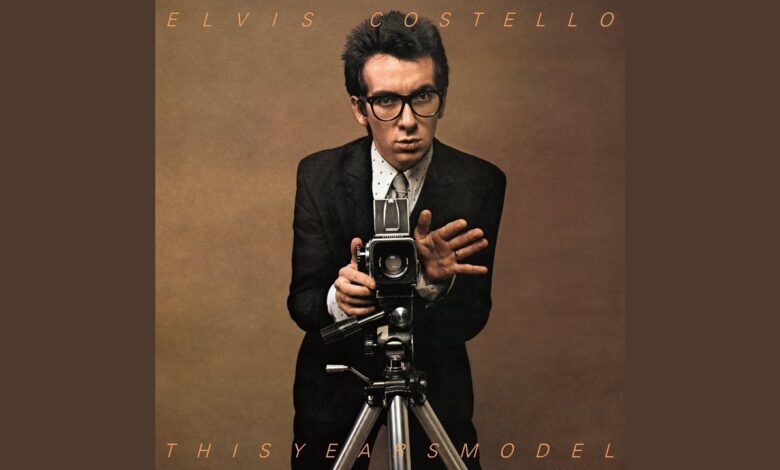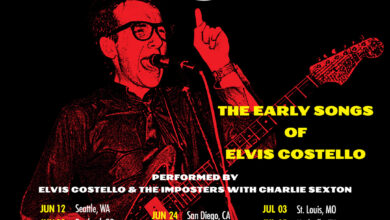Behind the Album: ‘This Year’s Model,’ the LP Where Elvis Costello Introduced the World to the Attractions

His debut album garnered the hype, but didn’t quite capture the sounds swirling in his head. Elvis Costello rectified that on his 1978 sophomore album This Year’s Model, in part by unleashing his newly formed band the Attractions all over his superbly written songs. The album cemented Costello as a writer of rare talent, while the band he assembled put the right spin on his words with unwavering accuracy. Not bad for a guy who had only quit his day job less as a computer operator less than a year before. Here is a look back at the whirlwind path Costello and friends took to this masterpiece album.
Coming Attractions
On his 1977 debut album My Aim is True, Costello was backed primarily by a U.S. band known as Clover, some of whom would later go on to join Huey Lewis as members of the News. The band did a bang-up job, but theirs was a mostly unobtrusive style of playing. Their style cast Costello in somewhat of a singer/songwriter light, which wasn’t quite the right fit. Costello wanted something more aggressive to back up his songs, and since Clover had their own career to worry about, he’d also need someone to play live behind him as he toured the first record. That album arrived in July 1977, a few weeks after auditions were held to cast the members of the new band.
It is simply amazing that blind auditions produced a band as talented and unique as the Attractions. Drummer Pete Thomas and bassist Bruce Thomas (no relation) both had recording and touring experience. Pete could batter away at a rapid pace or provide subtle touches behind ballads. Bruce created fascinating countermelodies behind Costello’s vocal lines. As for classically trained keyboardist Steve Nieve, not even 20 when he was hired to be in the band, he had no rock music experience at all, which ended up working in his favor. He simply added colorful flourishes that came naturally to him when he heard the songs, perhaps not even realizing he was doing something special.
For Costello, they were the ideal backing band. Because of their interplay and power, he didn’t feel the need for any heroics on lead guitar. He could simply add the occasional fill or lick without the need for solos, which he didn’t particularly like anyway. Most of all, the band served Costello’s songs ideally, their inventive arrangements and punchy embellishments complementing the dizzying torrent of lyrics that poured out of Costello.
“Model” Behavior
By the time Costello settled in to make This Year’s Model in December 1977, his star had risen considerably from when he first formed the Attractions. The release of My Aim is True brought with it a groundswell of critical acclaim. And when people heard the band live for the first time, they were stunned by the potency and chemistry of this quartet who had formed on the fly.
This Year’s Model came together in just a couple of weeks in December ’77 and January ’78. By that time, Costello and company had been playing the vast majority of the dozen tracks often in their live shows, so they knew exactly how the songs worked best. Nick Lowe, who also produced the debut album, once again provided his expertise in how to make the songs sound off-the-cuff and spirited. Overdubs were kept to a minimum because the band had such a comfort level playing them.
And what a set of songs did Costello deliver. He had a knack for finding the frustrations and inadequacies inherent in life and railing against them with furious eloquence. Even though you might not know all the local references in “(I Don’t Want to Go to) Chelsea,” you can relate to his disgust at the awful behavior on display. And even though you might not be privy to the rock-star decadence that informed “Pump It Up,” you can find catharsis in his venting.
In between the diatribes, Costello could dabble in empathy as well, as he showed in the title track. Meanwhile, the full-throttle attack of the Attractions on songs like “No Action” and “Lipstick Vogue” demonstrates what punk could have been if all the players had been as talented as these four guys. The U.S. version of the album adds the thrillingly confrontational “Radio Radio” as the closing track to put a perfect bow on the proceedings.
Elvis Costello’s catalog has roamed very far afield from a stylistic standpoint over the years, and many of those divergent paths produced albums of exquisite brilliance. Still, it’s hard to top the breathless rush you get from listening to This Year’s Model, that firecracker of an album when Costello found the Attractions, the ideal delivery system for all his fury and passion.



